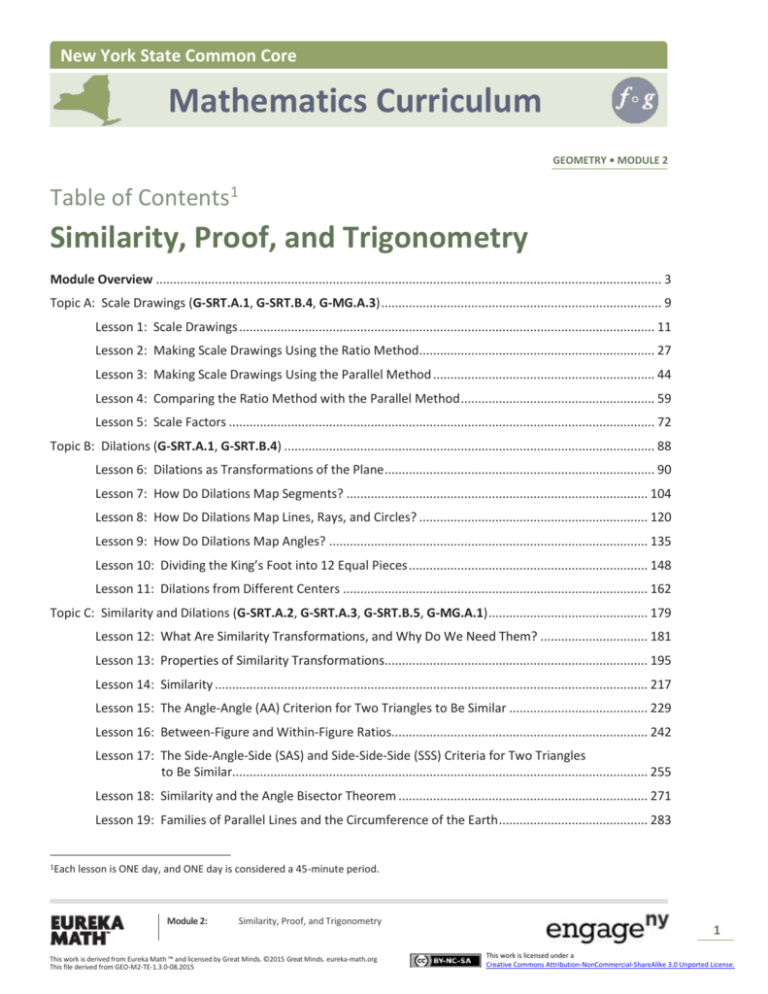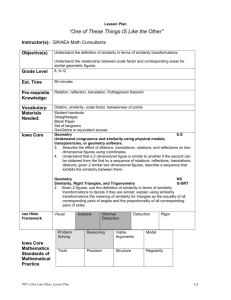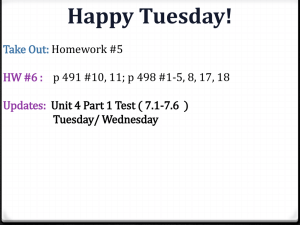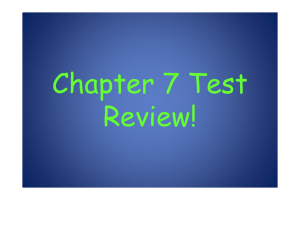Geometry Module 2: Module Overview
advertisement

New York State Common Core Mathematics Curriculum GEOMETRY • MODULE 2 Table of Contents1 Similarity, Proof, and Trigonometry Module Overview .................................................................................................................................................. 3 Topic A: Scale Drawings (G-SRT.A.1, G-SRT.B.4, G-MG.A.3) ................................................................................. 9 Lesson 1: Scale Drawings ........................................................................................................................ 11 Lesson 2: Making Scale Drawings Using the Ratio Method.................................................................... 27 Lesson 3: Making Scale Drawings Using the Parallel Method ................................................................ 44 Lesson 4: Comparing the Ratio Method with the Parallel Method ........................................................ 59 Lesson 5: Scale Factors ........................................................................................................................... 72 Topic B: Dilations (G-SRT.A.1, G-SRT.B.4) ........................................................................................................... 88 Lesson 6: Dilations as Transformations of the Plane .............................................................................. 90 Lesson 7: How Do Dilations Map Segments? ....................................................................................... 104 Lesson 8: How Do Dilations Map Lines, Rays, and Circles? .................................................................. 120 Lesson 9: How Do Dilations Map Angles? ............................................................................................ 135 Lesson 10: Dividing the King’s Foot into 12 Equal Pieces ..................................................................... 148 Lesson 11: Dilations from Different Centers ........................................................................................ 162 Topic C: Similarity and Dilations (G-SRT.A.2, G-SRT.A.3, G-SRT.B.5, G-MG.A.1) .............................................. 179 Lesson 12: What Are Similarity Transformations, and Why Do We Need Them? ............................... 181 Lesson 13: Properties of Similarity Transformations............................................................................ 195 Lesson 14: Similarity ............................................................................................................................. 217 Lesson 15: The Angle-Angle (AA) Criterion for Two Triangles to Be Similar ........................................ 229 Lesson 16: Between-Figure and Within-Figure Ratios.......................................................................... 242 Lesson 17: The Side-Angle-Side (SAS) and Side-Side-Side (SSS) Criteria for Two Triangles to Be Similar........................................................................................................................ 255 Lesson 18: Similarity and the Angle Bisector Theorem ........................................................................ 271 Lesson 19: Families of Parallel Lines and the Circumference of the Earth ........................................... 283 1Each lesson is ONE day, and ONE day is considered a 45-minute period. Module 2: Similarity, Proof, and Trigonometry This work is derived from Eureka Math ™ and licensed by Great Minds. ©2015 Great Minds. eureka-math.org This file derived from GEO-M2-TE-1.3.0-08.2015 1 This work is licensed under a Creative Commons Attribution-NonCommercial-ShareAlike 3.0 Unported License. NYS COMMON CORE MATHEMATICS CURRICULUM Module Overview M2 GEOMETRY Lesson 20: How Far Away Is the Moon? ............................................................................................... 297 Mid-Module Assessment and Rubric ................................................................................................................ 307 Topics A through C (assessment 1 day, return 1 day, remediation or further applications 4 days) Topic D: Applying Similarity to Right Triangles (G-SRT.B.4) ............................................................................. 334 Lesson 21: Special Relationships Within Right Triangles—Dividing into Two Similar Sub-Triangles ...................................................................................................................... 335 Lesson 22: Multiplying and Dividing Expressions with Radicals ........................................................... 349 Lesson 23: Adding and Subtracting Expressions with Radicals ............................................................ 365 Lesson 24: Prove the Pythagorean Theorem Using Similarity.............................................................. 375 Topic E: Trigonometry (G-SRT.C.6, G-SRT.C.7, G-SRT.C.8) ................................................................................ 387 Lesson 25: Incredibly Useful Ratios ...................................................................................................... 389 Lesson 26: The Definition of Sine, Cosine, and Tangent....................................................................... 404 Lesson 27: Sine and Cosine of Complementary Angles and Special Angles ......................................... 417 Lesson 28: Solving Problems Using Sine and Cosine ............................................................................ 427 Lesson 29: Applying Tangents .............................................................................................................. 440 Lesson 30: Trigonometry and the Pythagorean Theorem .................................................................... 453 Lesson 31: Using Trigonometry to Determine Area ............................................................................. 466 Lesson 32: Using Trigonometry to Find Side Lengths of an Acute Triangle ......................................... 477 Lesson 33: Applying the Laws of Sines and Cosines ............................................................................. 489 Lesson 34: Unknown Angles ................................................................................................................. 502 End-of-Module Assessment and Rubric ............................................................................................................ 515 Topics A through E (assessment 1 day, return 1 day, remediation or further applications 4 days) Module 2: Similarity, Proof, and Trigonometry This work is derived from Eureka Math ™ and licensed by Great Minds. ©2015 Great Minds. eureka-math.org This file derived from GEO-M2-TE-1.3.0-08.2015 2 This work is licensed under a Creative Commons Attribution-NonCommercial-ShareAlike 3.0 Unported License. NYS COMMON CORE MATHEMATICS CURRICULUM Module Overview M2 GEOMETRY Geometry • Module 2 Similarity, Proof, and Trigonometry OVERVIEW Just as rigid motions are used to define congruence in Module 1, so dilations are added to define similarity in Module 2. To be able to define similarity, there must be a definition of similarity transformations and, consequently, a definition for dilations. Students are introduced to the progression of terms beginning with scale drawings, which they first study in Grade 7 (Module 1 Topic D), but in a more observational capacity than in high school Geometry: Students determine the scale factor between a figure and a scale drawing or predict the lengths of a scale drawing, provided a figure and a scale factor. In Topic A, students begin with a review of scale drawings in Lesson 1, followed by two lessons on how to systematically create scale drawings. The study of scale drawings, specifically the way they are constructed under the ratio and parallel methods, gives us the language to examine dilations. The comparison of why both construction methods (MP.7) result in the same image leads to two theorems: the triangle side splitter theorem and the dilation theorem. Note that while dilations are defined in Lesson 2, it is the dilation theorem in Lesson 5 that begins to tell us how dilations behave (G-SRT.A.1, G-SRT.A.4). Topic B establishes a firm understanding of how dilations behave. Students prove that a dilation maps a line to itself or to a parallel line and, furthermore, dilations map segments to segments, lines to lines, rays to rays, circles to circles, and an angle to an angle of equal measure. The lessons on proving these properties, Lessons 7–9, require students to build arguments based on the structure of the figure in question and a handful of related facts that can be applied to the situation (e.g., the triangle side splitter theorem is called on frequently to prove that dilations map segments to segments and lines to lines) (MP.3, MP.7). Students apply their understanding of dilations to divide a line segment into equal pieces and explore and compare dilations from different centers. In Topic C, students learn what a similarity transformation is and why, provided the right circumstances, both rectilinear and curvilinear figures can be classified as similar (G-SRT.A.2). After discussing similarity in general, the scope narrows, and students study criteria for determining when two triangles are similar (G-SRT.A.3). Part of studying triangle similarity criteria (Lessons 15 and 17) includes understanding side length ratios for similar triangles, which begins to establish the foundation for trigonometry (G-SRT.B.5). The final two lessons demonstrate the usefulness of similarity by examining how two ancient Greek mathematicians managed to measure the circumference of the earth and the distance to the moon, respectively (G-MG.A.1). Module 2: Similarity, Proof, and Trigonometry This work is derived from Eureka Math ™ and licensed by Great Minds. ©2015 Great Minds. eureka-math.org This file derived from GEO-M2-TE-1.3.0-08.2015 3 This work is licensed under a Creative Commons Attribution-NonCommercial-ShareAlike 3.0 Unported License. NYS COMMON CORE MATHEMATICS CURRICULUM Module Overview M2 GEOMETRY In Topic D, students are laying the foundation to studying trigonometry by focusing on similarity between right triangles in particular (the importance of the values of corresponding length ratios between similar triangles is particularly apparent in Lessons 16, 21, and 25). Students discover that a right triangle can be divided into two similar sub-triangles (MP.2) to prove the Pythagorean theorem (G-SRT.B.4). Two lessons are spent studying the algebra of radicals that is useful for solving for sides of a right triangle and computing trigonometric ratios. An introduction to trigonometry, specifically right triangle trigonometry and the values of side length ratios within right triangles, is provided in Topic E by defining the sine, cosine, and tangent ratios and using them to find missing side lengths of a right triangle (G-SRT.B.6). This is in contrast to studying trigonometry in the context of functions, as is done in Algebra II of this curriculum. Students explore the relationships between sine, cosine, and tangent using complementary angles and the Pythagorean theorem (G-SRT.B.7, G-SRT.B.8). Students discover the link between how to calculate the area of a non-right triangle through algebra versus trigonometry. Topic E continues with a study of the laws of sines and cosines to apply them to solve for missing side lengths of an acute triangle (G-SRT.D.10, G-SRT.D.11). Topic E closes with Lesson 34, which introduces students to the functions arcsin, arccos, and arctan, which are formally taught as inverse functions in Algebra II. Students use what they know about the trigonometric functions sine, cosine, and tangent to make sense of arcsin, arccos, and arctan. Students use these new functions to determine the unknown measures of angles of a right triangle. Throughout the module, students are presented with opportunities to apply geometric concepts in modeling situations. Students use geometric shapes to describe objects (G-MG.A.1) and apply geometric methods to solve design problems where physical constraints and cost issues arise (G-MG.A.3). Focus Standards Understand similarity in terms of similarity transformations. G-SRT.A.1 Verify experimentally the properties of dilations given by a center and a scale factor: a. A dilation takes a line not passing through the center of the dilation to a parallel line, and leaves a line passing through the center unchanged. b. The dilation of a line segment is longer or shorter in the ratio given by the scale factor. G-SRT.A.2 Given two figures, use the definition of similarity in terms of similarity transformations to decide if they are similar; explain using similarity transformations the meaning of similarity for triangles as the equality of all corresponding pairs of angles and the proportionality of all corresponding pairs of sides. G-SRT.A.3 Use the properties of similarity transformations to establish the AA criterion for two triangles to be similar. Module 2: Similarity, Proof, and Trigonometry This work is derived from Eureka Math ™ and licensed by Great Minds. ©2015 Great Minds. eureka-math.org This file derived from GEO-M2-TE-1.3.0-08.2015 4 This work is licensed under a Creative Commons Attribution-NonCommercial-ShareAlike 3.0 Unported License. NYS COMMON CORE MATHEMATICS CURRICULUM Module Overview M2 GEOMETRY Prove theorems involving similarity. G-SRT.B.4 Prove theorems about triangles. Theorems include: a line parallel to one side of a triangle divides the other two proportionally, and conversely; the Pythagorean Theorem proved using triangle similarity. G-SRT.B.5 Use congruence and similarity criteria for triangles to solve problems and to prove relationships in geometric figures. Define trigonometric ratios and solve problems involving right triangles. G-SRT.C.6 Understand that by similarity, side ratios in right triangles are properties of the angles in the triangle, leading to definitions of trigonometric ratios for acute angles. G-SRT.C.7 Explain and use the relationship between the sine and cosine of complementary angles. G-SRT.C.8 Use trigonometric ratios and the Pythagorean Theorem to solve right triangles in applied problems.★ Apply geometric concepts in modeling situations. G-MG.A.1 Use geometric shapes, their measures, and their properties to describe objects (e.g., modeling a tree trunk or a human torso as a cylinder).★ G-MG.A.3 Apply geometric methods to solve design problems (e.g., designing an object or structure to satisfy physical constraints or minimize cost; working with typographic grid systems based on ratios).★ Extension Standards Apply trigonometry to general triangles. G-SRT.D.9 (+) Derive the formula 𝐴 = 1/2 𝑎𝑏 sin(𝐶) for the area of a triangle by drawing an auxiliary line from a vertex perpendicular to the opposite side. G-SRT.D.10 (+) Prove the Laws of Sines and Cosines and use them to solve problems. G-SRT.D.11 (+) Understand and apply the Law of Sines and the Law of Cosines to find unknown measurements in right and non-right triangles (e.g., surveying problems, resultant forces). Foundational Standards Draw, construct, and describe geometrical figures and describe the relationships between them. 7.G.A.1 Solve problems involving scale drawings of geometric figures, including computing actual lengths and areas from a scale drawing and reproducing a scale drawing at a different scale. Module 2: Similarity, Proof, and Trigonometry This work is derived from Eureka Math ™ and licensed by Great Minds. ©2015 Great Minds. eureka-math.org This file derived from GEO-M2-TE-1.3.0-08.2015 5 This work is licensed under a Creative Commons Attribution-NonCommercial-ShareAlike 3.0 Unported License. NYS COMMON CORE MATHEMATICS CURRICULUM Module Overview M2 GEOMETRY Understand congruence and similarity using physical models, transparencies, or geometry software. 8.G.A.3 Describe the effect of dilations, translations, rotations, and reflections on two-dimensional figures using coordinates. 8.G.A.4 Understand that a two-dimensional figure is similar to another if the second can be obtained from the first by a sequence of rotations, reflections, translations, and dilations; given two similar two-dimensional figures, describe a sequence that exhibits the similarity between them. 8.G.A.5 Use informal arguments to establish facts about the angle sum and exterior angle of triangles, about the angles created when parallel lines are cut by a transversal, and the angle-angle criterion for similarity of triangles. For example, arrange three copies of the same triangle so that the sum of the three angles appears to form a line, and give an argument in terms of transversals why this is so. Focus Standards for Mathematical Practice MP.3 Construct viable arguments and critique the reasoning of others. Critical to this module is the need for dilations in order to define similarity. In order to understand dilations fully, the proofs in Lessons 4 and 5 to establish the triangle side splitter and the dilation theorems require students to build arguments based on definitions and previously established results. This is also apparent in Lessons 7, 8, and 9, when the properties of dilations are being proven. Though there are only a handful of facts students must point to in order to create arguments, how students reason with these facts determine if their arguments actually establish the properties. It is essential to communicate effectively and purposefully. MP.7 Look for and make use of structure. Much of the reasoning in Module 2 centers around the interaction between figures and dilations. It is unsurprising, then, that students must pay careful attention to an existing structure and how it changes under a dilation, for example, why it is that dilating the key points of a figure by the ratio method results in the dilation of the segments that join them. The math practice also ties into the underlying idea of trigonometry: how to relate the values of corresponding ratio lengths between similar right triangles and how the value of a trigonometric ratio hinges on a given acute angle within a right triangle. Terminology New or Recently Introduced Terms Cosine (Let 𝜃 be the angle measure of an acute angle of the right triangle. The cosine of 𝜃 of a right triangle is the value of the ratio of the length of the adjacent side (denoted adj) to the length of the hypotenuse (denoted hyp). As a formula, cos 𝜃 = adj/hyp.) Module 2: Similarity, Proof, and Trigonometry This work is derived from Eureka Math ™ and licensed by Great Minds. ©2015 Great Minds. eureka-math.org This file derived from GEO-M2-TE-1.3.0-08.2015 6 This work is licensed under a Creative Commons Attribution-NonCommercial-ShareAlike 3.0 Unported License. NYS COMMON CORE MATHEMATICS CURRICULUM Module Overview M2 GEOMETRY Dilation (For 𝑟 > 0, a dilation with center 𝐶 and scale factor 𝑟 is a transformation 𝐷𝐶,𝑟 of the plane defined as follows: 1. For the center 𝐶, 𝐷𝐶,𝑟 (𝐶) = 𝐶, and 2. For any other point 𝑃, 𝐷𝐶,𝑟 (𝑃) is the point 𝑄 on ⃗⃗⃗⃗⃗ 𝐶𝑃 so that 𝐶𝑄 = 𝑟 ∙ 𝐶𝑃.) Sides of a Right Triangle (The hypotenuse of a right triangle is the side opposite the right angle; the other two sides of the right triangle are called the legs. Let 𝜃 be the angle measure of an acute angle of the right triangle. The opposite side is the leg opposite that angle. The adjacent side is the leg that is contained in one of the two rays of that angle (the hypotenuse is contained in the other ray of the angle).) Similar (Two figures in a plane are similar if there exists a similarity transformation taking one figure onto the other figure. A congruence is a similarity with scale factor 1. It can be shown that a similarity with scale factor 1 is a congruence.) Similarity Transformation (A similarity transformation (or similarity) is a composition of a finite number of dilations or basic rigid motions. The scale factor of a similarity transformation is the product of the scale factors of the dilations in the composition; if there are no dilations in the composition, the scale factor is defined to be 1. A similarity is an example of a transformation.) Sine (Let 𝜃 be the angle measure of an acute angle of the right triangle. The sine of 𝜃 of a right triangle is the value of the ratio of the length of the opposite side (denoted opp) to the length of the hypotenuse (denoted hyp). As a formula, sin 𝜃 = opp/hyp.) Tangent (Let 𝜃 be the angle measure of an acute angle of the right triangle. The tangent of 𝜃 of a right triangle is the value of the ratio of the length of the opposite side (denoted opp) to the length of the adjacent side (denoted adj). As a formula, tan 𝜃 = opp/adj.) Note that in Algebra II, sine, cosine, and tangent are thought of as functions whose domains are subsets of the real numbers; they are not considered as values of ratios. Thus, in Algebra II, the values of these functions for a given 𝜃 are notated as sin(𝜃), cos(𝜃), and tan(𝜃) using function notation (i.e., parentheses are included). Familiar Terms and Symbols2 2These Composition Dilation Pythagorean theorem Rigid motions Scale drawing Scale factor Slope are terms and symbols students have seen previously. Module 2: Similarity, Proof, and Trigonometry This work is derived from Eureka Math ™ and licensed by Great Minds. ©2015 Great Minds. eureka-math.org This file derived from GEO-M2-TE-1.3.0-08.2015 7 This work is licensed under a Creative Commons Attribution-NonCommercial-ShareAlike 3.0 Unported License. Module Overview NYS COMMON CORE MATHEMATICS CURRICULUM M2 GEOMETRY Suggested Tools and Representations Compass and straightedge Assessment Summary Assessment Type Administered Format Standards Addressed Mid-Module Assessment Task After Topic C Constructed response with rubric G-SRT.A.1, G-SRT.A.2, G-SRT.A.3, G-SRT.B.4, G-SRT.B.5, G-MG.A.1, G-MG.A.3 End-of-Module Assessment Task After Topic E Constructed response with rubric G-SRT.B.4, G-SRT.B.5, G-SRT.C.6, G-SRT.C.7, G-SRT.C.8 Module 2: Similarity, Proof, and Trigonometry This work is derived from Eureka Math ™ and licensed by Great Minds. ©2015 Great Minds. eureka-math.org This file derived from GEO-M2-TE-1.3.0-08.2015 8 This work is licensed under a Creative Commons Attribution-NonCommercial-ShareAlike 3.0 Unported License.







